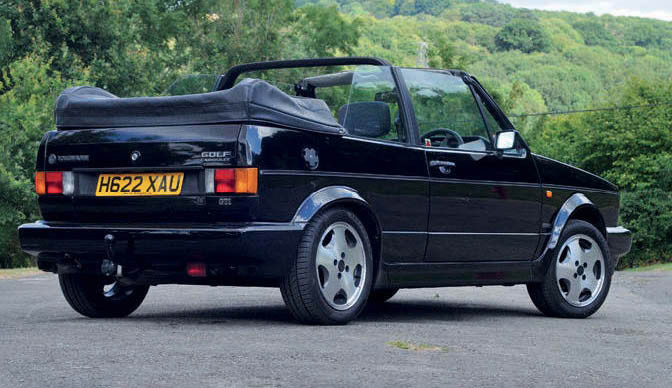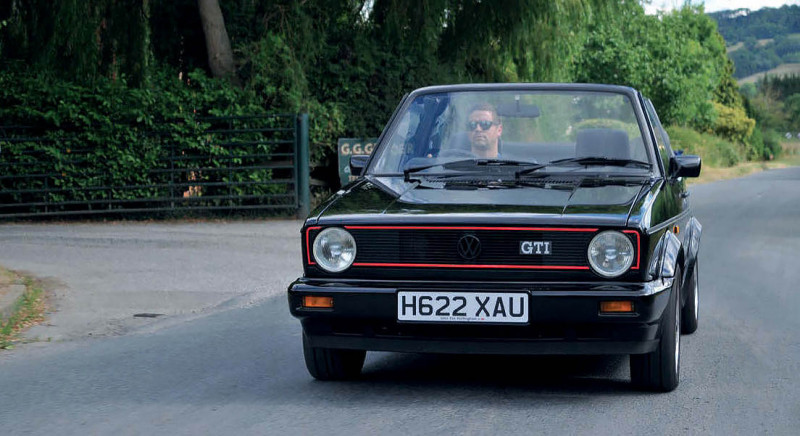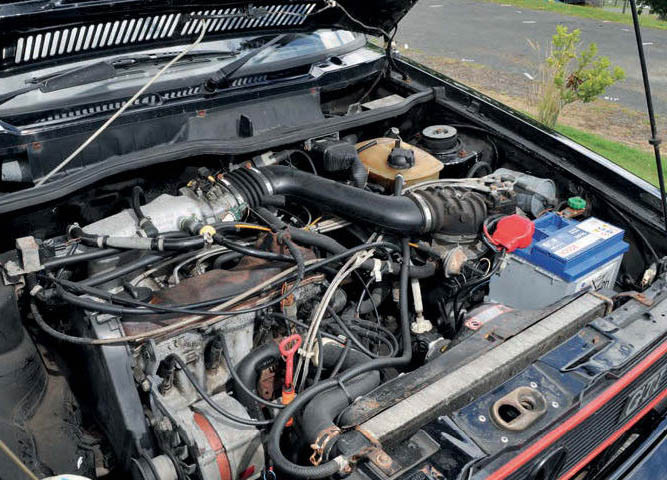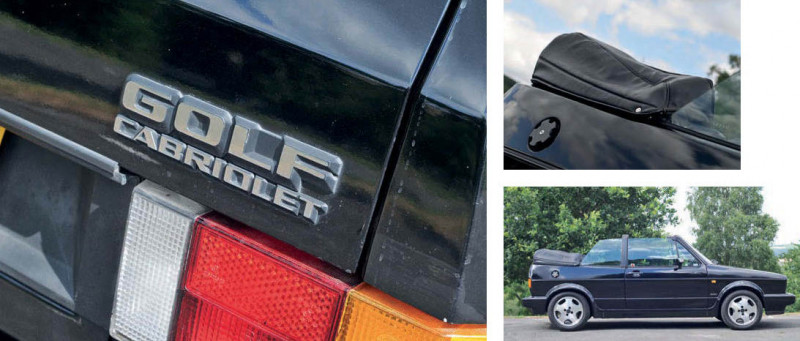1977 Volkswagen Golf GTi Cabriolet Mk1
The Mk1 Golf Cabriolet can often be had for far smaller sums than the regular hatch, especially when it comes to the GTI. But does it make for a great summer classic, or a floppy-topped folly?
Words: Jeff Ruggles
Photography: Paul Wager
ROAD TEST: GOLF CABRIOLET
The topless VW Golf GTI is much cheaper than the iconic hatch version, but is it as much fun?

Although it wasn’t the first to combine a more powerful engine with a hatchback bodyshell, Volkswagen’s decision to create the Golf GTI in 1976 essentially invented the hot hatch as we know it. And three years later, the German giant’s open-topped version of the Golf would make similar inroads, leaving rival manufacturers scurrying to build their own copies.

The four-seater Cabriolet was a latecomer to the Golf range but ended up outlasting the hatchback on which it was based by a decade. It was available with the same power unit as the GTI right from the outset, and would officially adopt the GTI nomenclature from 1984. However, while the tin-topped version has become an established motoring icon and often has a price tag to match, the open-topped car has never quite hit the same heights despite being a bestseller in its class and adding wind-in-the- hair motoring to the Golf’s already impressive do-anything repertoire. Thankfully, we recently acquired a 1990 GTI Cabriolet (more on that in a future issue), which gave us the ideal opportunity to see how the open-topped variant stands up today.

By 1990 of course, the Mk1 Cabriolet was very much in later life, with the hatchback having been launched way back in 1974. A convertible version of the Golf had been presented to Volkswagen’s management by coachbuilder Karmann as early as 1976, but we had to wait until the Geneva Motor Show in February 1979 for the production version of the topless Golf to be unveiled.
Built in-house by Karmann from June of that year, the four-seater Cabriolet was comprehensively strengthened to compensate for the lack of roof. Changes included enlarged sill members and crossmembers added transversely under the dash and the rear seat. The inner wings were also reinforced at the front, together with the front structure of the body, while the windscreen frame and scuttle pressings were new. The rear end structure was entirely revised to accommodate the folding roof, with the boot space now accessed through a narrow hatch. The most obvious change, though, was the addition of a Triumph Stag-style rollover hoop that was missing from the prototype version, which also conveniently provided seatbelt anchorages. At first the open Golf was produced alongside the Beetle Cabriolet, but this would only last for six months, leaving the Golf to go it alone as a Beetle replacement.

Initially, the Cabriolet was offered in most countries as the GLi with a 1.6-litre GTI engine and stiffer suspension, alongside the GLS with its 70bhp 1.5-litre unit. The GLi convertible got the 1.8-litre GTI engine in 1982 and the smaller petrol lump was replaced by a 1.6-litre carburettor unit in 1983. The dash was refashioned in 1981 to include a lockable glovebox and centre console, while better sports seats became standard from 1983. From 1984, the bigger-engined car wore GTI badging, and the 1.6 GL was now available with auto and 4+E gearbox options.
By then, the Mk1 hatch had been replaced by the Mk2, but since the existing Cabriolet was so popular, Volkswagen decided against spending out on developing a new one and the topless version would keep the retro lines of the original Golf for much longer. However, in 1988 there was an attempt at modernisation when bigger moulded bumpers with integrated front and rear spoilers went on, combined with chunkier wheelarch extensions and sideskirts. This is commonly known as the ‘Clipper’ kit, referencing the 1.8-litre carb-fed Clipper model that replaced the GL. Rather confusingly though, when the Clipper was first offered for 1986, it came without the bodykit.
Spec levels were improved in 1990 and for the first time a hydraulically operated power hood became an option on GTI models. For the final three years of production, buyers could get their hands on the Sportline model with its Recaro seats and BBS wheels, as well as the posh Rivage with its Classic Blue paint, Mauritius Blue cloth interior and Indigo Blue hood. There was also the Rivage Leather edition, available in Classic Green Pearl metallic and named after its beige leather seats. These final cars are rare, but our test car does a least have some Rivage air about it, thanks to set of polished 15- inch wheels borrowed from the more illustrious model. In the end, 388,552 Mk1 Cabriolets were built, meaning it outsold the open-topped Beetle and, in 1991, set a record for being the world’s best-selling convertible. It was eventually replaced in 1994 by a new version based on the Mk3 hatch. Like the Mk1, this incarnation survived two generations, effectively remaining the same basic car when it was revised into the Mk4 version in 1998.
With a mere 89,000 miles showing, our GTI boasts relatively low mileage compared to most examples, and save for the aforementioned wheels, a different grille, an official VW towbar and a subtle exhaust upgrade, it’s standard. It was collected from an auction in Newcastle upon Tyne and driven down to Cheltenham, where it has since been enjoyed on the local roads around areas like Prescott Hillclimb, so we’ve certainly had plenty of time to get acquainted with it. The first thing we noted ahead of our long drive was the Cabriolet’s practicality. The rear seats fold down just like a regular Golf hatch, meaning you can squeeze a pushbike in with some thought. The only restriction is height, as part of Karmann’s strengthening work involved a welded- in rear parcel shelf, but if you can get it in under the shelf in a Mk1 Golf hatch, it’ll fit in the Cabriolet too.
Naturally, the GTI Cabriolet is heavier than the tin-top thanks to all that extra strengthening, causing a penalty of around 130kg. You’d expect that to blunt things, and the figures suggest the 0-60mph sprint is lengthened by 0.3 seconds. Behind the wheel though, there’s still a pleasing amount of grunt on tap from the 1.8-litre engine and this 32-year-old still feels very lively amongst modern traffic, sweetly accompanied by a light burble from the exhaust. The original Golf GTI Mk1 really was a stand-out, feeling so much newer than its years, and this Cabriolet is still impressively crisp and brisk. It cruises at motorways speeds with ease and has more than enough power to be fun in the twisty bits, making it an exceptionally usable modern classic. It handles well too, with the sharp turn in and modest body roll you’d expect of a GTI. At first there appeared to be noticeable scuttle shake, but on closer inspection the front suspension top mounts were past their best and caused the front end to be ‘looser’ than it should be. This is a common VW problem, so it’s something to bear in mind when buying. Thankfully, our car was still tremendously enjoyable, and should be even better when new mounts are fitted.
There’s also plenty of grip courtesy of the bigger 15-inch wheels and modern tyres, though they can tramline on occasion and the low-profile tyre means the ride is not as good as with the stock 14-inch rims. That said, the Rivage wheels do wonders for the car’s looks, so the trade-off is worth it. The steering has no power assistance, save from on a few of the final left-hand drive cars or if retrofitted. This means parking requires some effort, not helped by the bigger wheels or when the hood is down and impairing rearward visibility. However, when on the move the steering gives rich feedback and allows you to gauge the level of grip easily. The seats also keep you in position nicely, and in this car they are in impressive condition given their age. Less impressive is the amount of wind noise, which is very noticeable when motorway driving. This car has the later electric hood and doesn’t leak, but perhaps needs some attention to ensure air is passing over the hood when it’s up rather than into the cabin.
The big elephant in the room, however, is the brakes. The Golf was originally designed as a left-hand drive car, meaning a complicated and rather Heath Robinson left-to-right brake linkage that robs the brakes of feel and makes using them rather unpleasant in action – a common complaint for all right-hand drive Mk1s, but especially the GTI with its extra power. The gearshift is also rather notchy and loose, but this is a common Mk1 problem and can be improved with readily available new bushes. In truth, the latter is indicative of what you might expect to find on a car like this even if it’s generally been looked after, and we’re confident any minor niggles could be easily sorted with a couple of days’ work.
Even with these minor issues, it’s very easy to fall for the Cabriolet. Like the hatchback version, it’s quick, nimble and fun, but with the added bonus of being able to get the roof down and enjoy the sunshine. If the Mk1 GTI is archetypal hot hatch, then the GTI Cabriolet is surely the archetypal hot four-seater cabrio, and still makes for an engaging and exciting driver’s car even today. All things being equal, the hatch would still get our nod, but they are not equal. The Cabriolet can often be found for less than half the price of its tin-topped equivalent but offers way more than only half the fun. To our minds, that makes this sun-seeker a bit of a bargain.
The 1.8-litre engine still feels very lively amongst modern traffic. Despite the smaller boot opening, the Cabriolet is still remarkably practical.
A GTI Cabriolet can be had for less than half the price of the iconic hatch, but still makes for a exciting drive. The Golf Cabriolet was a latecomer to the range, but outlasted the hatch by a decade.
SPECIFICATIONS 1977 Volkswagen Golf GTi Cabriolet Mk1
- ENGINE 1781cc
- MAX POWER 112bhp at 5800rpm
- MAX TORQUE 113lb.ft at 3500rpm
- 0-60 MPH 9.5secs
- MAX SPEED 108mph
- ECONOMY 34mpg
- LENGTH 3.89m
- WIDTH 1.64m
- KERB WEIGHT 995kg


